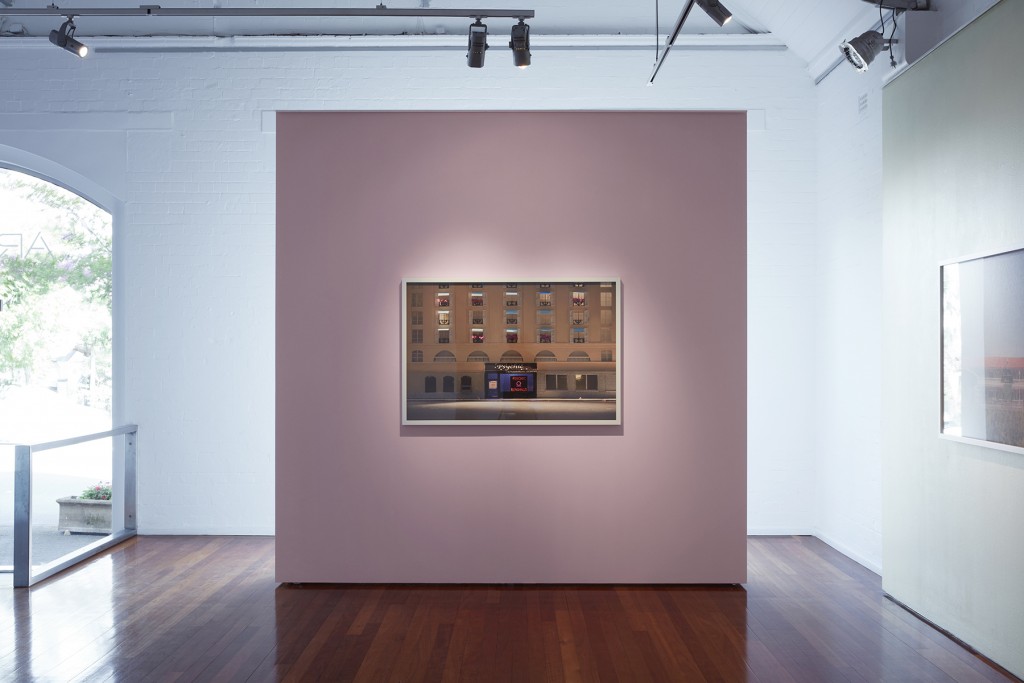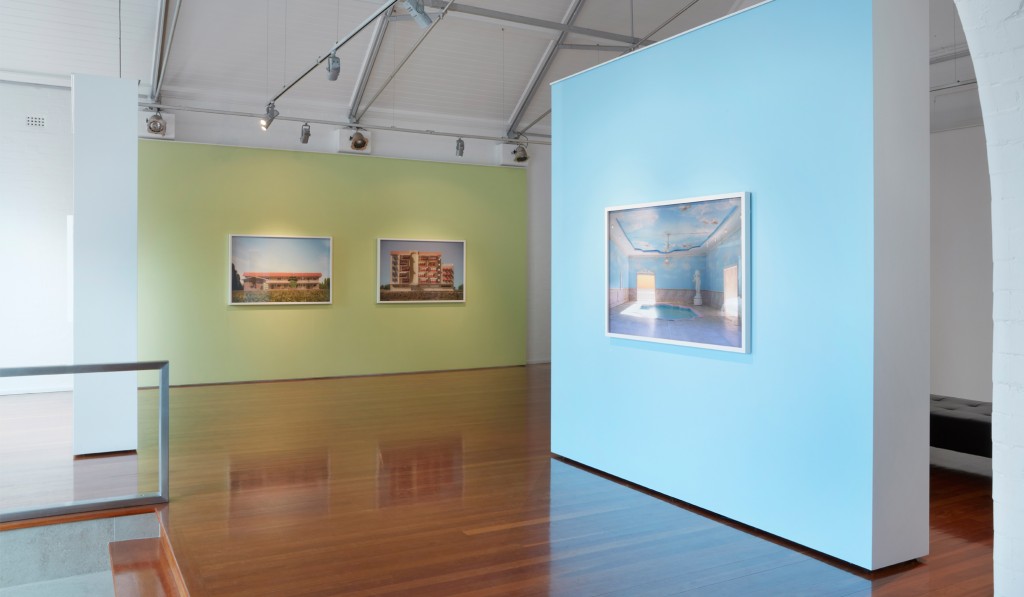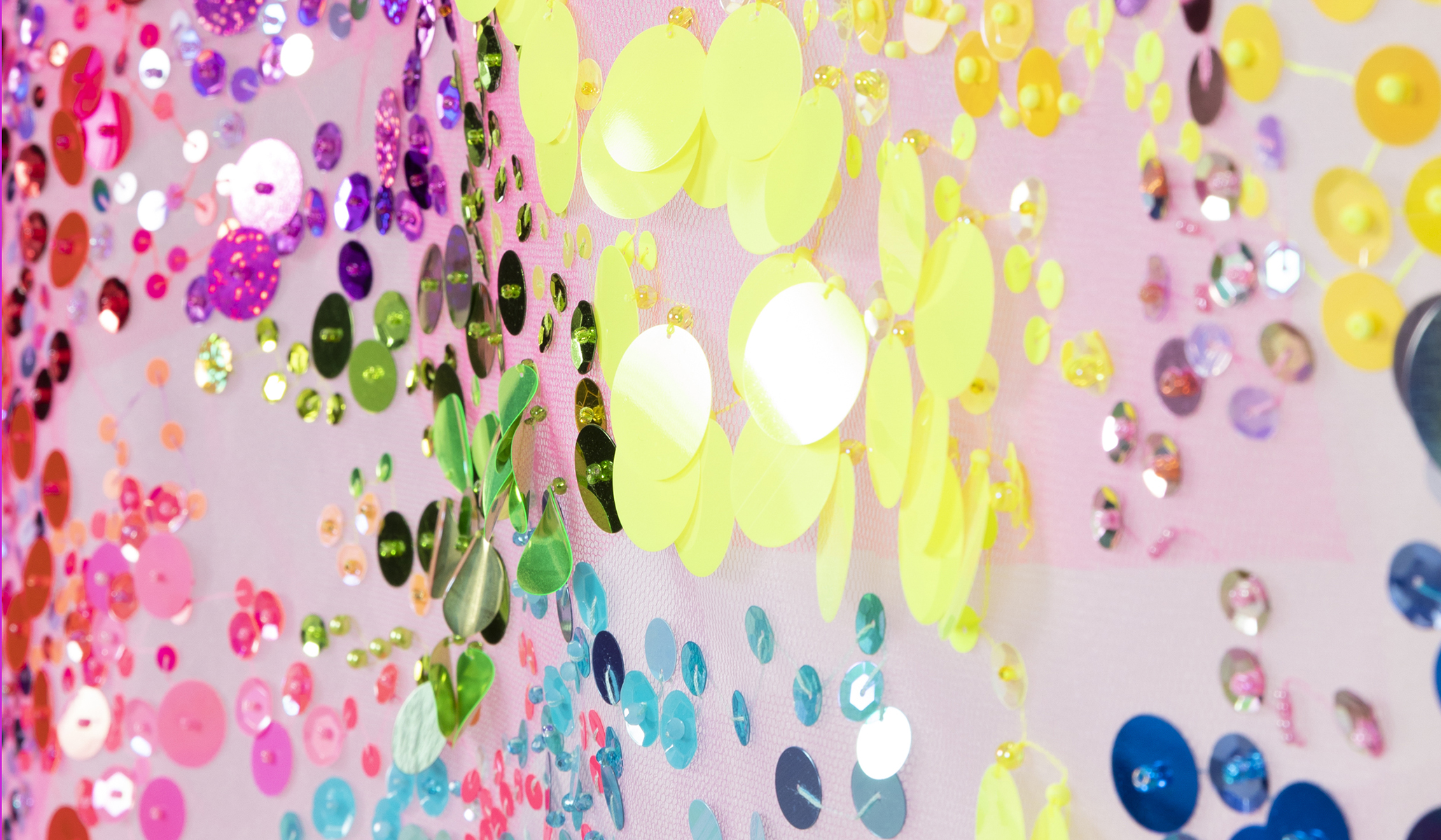Exhibition
Presented as part of Art Month Sydney, ‘Faraway’ draws inspiration
from Anna Carey’s recent travels in Europe…
With works held in significant international collections such as the Los Angeles County Museum of Art and the National Gallery of Australia, Anna Carey is well known for creating works which focuses on architectural spaces as a medium to open up an imaginative realm for the viewer.
Using memory and recall as the only reference of permanency, Carey interweaves model-making, drawing and photography to create fictive architectural spaces based on the urban environments of cities such as her hometown of the Gold Coast in Queensland, alongside Los Angeles, Las Vegas, Palm Springs – and now more recently, Paris and the South of France…

Anna Carey’s artworks are haunted by something familiar. Known for her iconic representations of her hometown the Gold Coast, alongside locations such as Las Vegas, Palm Springs and Los Angeles (where she currently lives and works), Carey’s practice draws on memory, imagination and nostalgia to create fictive architectural models which are then documented and presented as photographic and video works. Recently returned from time spent in Paris and a residency in the South of France, Carey’s latest body of work Faraway once again employs the construction of fragile, handmade architectural models, capturing dreamlike and eerily familiar scenes of French hotels, cliffside holiday apartments and Parisian street-scapes.
“This latest series shifts my focus from places in America and Australia and instead is based on my experience of places in Europe. Like all of my work the initial inspiration stems from a ‘Proustian’ moment of recalling memories that evoked a familiar feeling of déjà vu, as if I had been there before. This occurred when visiting castles that have been iconic backdrops for fantasy films, and also from familiar urban environments in Australia in which people create their own suburban castles by mixing vernacular and international styles to create a sense of fantasy and escape while at home. This omnipresent experience in contemporary urban environments is common within our globalised culture. The work aims to present a global generic architectural style through model making and photography, to heighten the blurred state one can experience when transiting between places in the world.”

Infused with a fairy-tale like quality and saturated in a soft and dreamy light reminiscent of a Sofia Coppola film, Carey’s works draw heavily on the language of film and the histories of architecture. Sampling, mixing and repeating motifs from both vernaculars in a way which feels at once highly realistic (echoing the way influences spread and disseminate across time and place) yet simultaneously lends the work a slightly odd quality. With closer inspection often revealing inconsistencies within the models that would never be found in real life – clues as it were – to their own illusory nature and the manner of their construction.
“I photographed these works with a deadpan approach, which in photography is typically a frontal approach and understood as an objective matter- of-fact visual delivery. Art historian Aron Vinegar proposes that deadpan is a mood of its own; a calm and open way of being in the world. It is a neutral framework and allows us to withhold judgment and sit alongside ‘everydayness’ and experience an authentic way of being-in-the-world. Imagination and poetry are also understood as other ways of being-in-the-world because poetry creates stillness and allows us to contemplate the world and the passing of time. My work combines imagination, the miniature, and deadpan photography to identify place through the simultaneous evocation of the poetic and the everyday.”

A modern-day flaneur, Carey is constantly observing her surroundings: cityscapes, landscapes, the mish- mash of architectural styles adopted in various locales, and the minute details and eccentricities that characterise interiors. More recently, Carey has been fascinated with the way in which particular locales world-wide tend to adopt certain colour palettes. Elaborating on the research she has been doing into these trends Carey explains:
“When seeing architecture in say Provence, South of France, that were painted green and surrounded by greenery I was reminded of other motels around the world similar to this provincial style. For instance, these types of places can be found in leafy green places in America and Australia that have decorated the architecture with green as the dominant colour. I know this to be true as I have researched and mapped out colour clusters all of the world. To do so I used Google maps, to create separate colour maps in which I have located, and saved motels based on their colour. Through this process, I identified dominant and popular colours of vernacular architecture in the world, revealing the connection between colour and place.”
Permeating Faraway is a longing for escapism. Where once Carey made works about Los Angeles and Las Vegas, faraway cities that she dreamed of from her home in Australia, these locales (which she now lives in or regularly visits) have perhaps become too familiar. Cue a new fascination with Paris and the South of France.
The promise of escape has always underpinned holiday destinations and cities which act as tourist magnets, and it is this attraction and the way in which it is communicated via architecture, that fascinates Carey. Visiting Paris, Carey saw the iconic visual language of France repeated and refracted. Baroque ceilings painted with dreamy skyscapes could be found in both chateaus and the local Starbucks. The migration of these visual tropes, and the way in which far off locales and their promised escapism are evoked in architecture is witnessed repeatedly in Carey’s work. Walking down a Paris street, Carey was struck by the familiar site of a Psychic’s storefront – a generic ‘New Age’ aesthetic that could have been easily transposed from the streets of Los Angeles. Inserting her own real life phone number into the psychic sign flashing from the storefront window, Carey beckons to the viewer, inviting them into a world which balances on the precipice of illusion and reality, escapism and the quotidian.
Growing up on the Gold Coast, Anna Carey’s early works were created in direct response to the oft- heard judgement that the Gold Coast is tacky, flashy and devoid of culture. Determined to document the character and charm which pervades her hometown, Carey became known for the way in which she managed to represent these everyday places. Suddenly something you’ve seen a million times before, and dismissed just as many times, becomes interesting and fascinating – a scene evoked in its full glory – the magic and the mundane shown in equal measure.
Building on this first series, we flash forward a decade and Carey has managed to achieve the same effect in her Faraway series. Foregoing the expected chateaus, Carey captures the common everyday elements of France. The provincial Mediterranean lifestyle of rural Provence, the ordinary everyday landscape of the French Riviera populated by cheap holiday apartments and mid- tier hotels and the unexpected moments where contemporary sub-culture pops up in the streets of Paris. Offering us a different narrative to that of the romanticised French fairytale, Carey shows us that the magic of these places lies in the act of viewing and remembering.
Perhaps Bachelard put it best when he said ‘‘the reader who is ‘reading a room’ leaves off reading and starts to think of some place in his own past. You would like to tell everything about your room. You would like to interest the reader into yourself, however you have unlocked a door to daydreaming.”
Ultimately, Anna Carey’s work reminds us that in a globalised world, no matter where you are, you will always find an echo of somewhere else.
Rhianna Walcott, Curator



